Flamingo
| Flamingos Temporal range: Late Oligocene – Recent
| |
|---|---|

| |
| James's flamingos (P. jamesi) | |
| Scientific classification | |
| Domain: | Eukaryota |
| Kingdom: | Animalia |
| Phylum: | Chordata |
| Class: | Aves |
| Order: | Phoenicopteriformes |
| Family: | Phoenicopteridae Bonaparte, 1831 |
| Genera | |
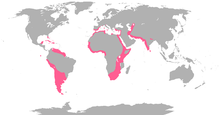
| |
| Global distribution of flamingos | |
Flamingos or flamingoes[a] /fləˈmɪŋɡoʊz/ are a type of wading bird in the family Phoenicopteridae, which is the only extant family in the order Phoenicopteriformes. There are four flamingo species distributed throughout the Americas (including the Caribbean), and two species native to Afro-Eurasia.
A group of flamingoes is called a "flamboyance".[2]
Etymology
The name flamingo comes from Portuguese or Spanish flamengo ("flame-colored"), which in turn comes from Provençal flamenc – a combination of flama ("flame") and a Germanic-like suffix -ing. The word may also have been influenced by the Spanish ethnonym flamenco ("Fleming" or "Flemish"). The name of the genus, Phoenicopterus, is from the Greek φοινικόπτερος phoinikopteros, lit. 'crimson/red-feathered');[3] other genera names include Phoeniconaias, which means "crimson/red water nymph (or naiad)", and Phoenicoparrus, which means "crimson/red bird (though, an unknown bird of omen)".
Taxonomy and systematics
The family Phoenicopteridae was introduced by the French zoologist Charles Lucien Bonaparte in 1831, with Phoenicopterus as the type genus.[4][5]
Traditionally, the long-legged
Relationship with grebes
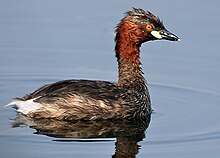
Recent molecular studies have suggested a relation with grebes,[12][13][14] while morphological evidence also strongly supports a relationship between flamingos and grebes. They hold at least 11 morphological traits in common, which are not found in other birds. Many of these characteristics have been previously identified on flamingos, but not on grebes.[15] The fossil palaelodids can be considered evolutionarily, and ecologically, intermediate between flamingos and grebes.[16]
For the grebe-flamingo clade, the taxon Mirandornithes ("miraculous birds" due to their extreme divergence and apomorphies) has been proposed. Alternatively, they could be placed in one order, with Phoenocopteriformes taking priority.[16]
Phylogeny
Living flamingos:[17]
| |||||||||||||||||||||||||||||||
Species
Six extant flamingo species are recognized by most sources, and were formerly placed in one genus (have common characteristics) – Phoenicopterus. As a result of a 2014 publication,[18] the family was reclassified into two genera.[19] In 2020, the family had three recognized genera, according to HBW.[20]
| Image | Species | Geographic location | |
|---|---|---|---|
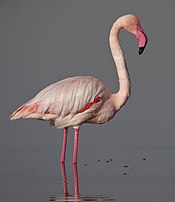
|
Greater flamingo(Phoenicopterus roseus) | Old World | Parts of Africa, S. Europe and S. and SW Asia (most widespread flamingo). |
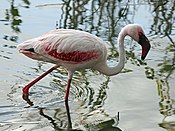
|
Lesser flamingo(Phoeniconaias minor) | Africa (e.g. Great Rift Valley) to NW India (most numerous flamingo). | |

|
Chilean flamingo(Phoenicopterus chilensis) | New World | Temperate S. South America. |
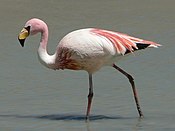
|
James's or Puna flamingo(Phoenicoparrus jamesi) | High Andes in Peru, Chile, Bolivia and Argentina. | |

|
Andean flamingo(Phoenicoparrus andinus) | High Andes in Peru, Chile, Bolivia and Argentina. | |
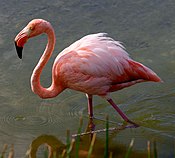
|
American or Caribbean flamingo(Phoenicopterus ruber) | Caribbean islands, Caribbean Mexico, southern Florida,[21] Belize, coastal Colombia, northern Brazil, Venezuela and Galápagos Islands. | |
Prehistoric species of flamingo:
- Elornis? Milne-Edwards, 1868 (Late Oligocene of France, Europe)[22]
- Harrisonavis (Gervais, 1852) (Middle Oligocene–Middle Miocene of C. Europe)[23]
- Leakeyornis (Harrison and Walker, 1976) (Early to Middle Miocene of Lake Victoria, Kenya)[24]
- Phoeniconaias proeses (De Vis 1905) (Pliocene of Lake Kanunka, Australia)[25]
- Phoeniconaias siamensis Cheneval et al. 1991 (Early Miocene of Mae Long Reservoir, Thailand)[26]
- Phoeniconotius Miller 1963 (Late Oligocene of South Australia)[27]
- Phoenicopterus copei (Miller 1963) (Late Pleistocene of North America and Mexico)[28]
- Phoenicopterus floridanus (Brodkorb 1953) (Early Pliocene of Florida)[29]
- Phoenicopterus minutus Howard 1955 (Late Pleistocene of California, US)[28]
- Phoenicopterus novaehollandiae Miller 1963 (Late Oligocene of South Australia)[27]
- Phoenicopterus stocki (Miller 1944) (Middle Pliocene of Rincón, Mexico)[30]
- Xenorhynchopsis De Vis 1905 (Pliocene to Pleistocene of Australia)[25]
Description
Flamingos usually stand on one leg with the other tucked beneath the body. The reason for this behaviour is not fully understood. One theory is that standing on one leg allows the birds to conserve more body heat, given that they spend a significant amount of time wading in cold water.[31] However, the behaviour also takes place in warm water and is also observed in birds that do not typically stand in water. An alternative theory is that standing on one leg reduces the energy expenditure for producing muscular effort to stand and balance on one leg. A study on cadavers showed that the one-legged pose could be held without any muscle activity, while living flamingos demonstrate substantially less body sway in a one-legged posture.[32]

While walking, a flamingo's legs may appear to bend backwards. This appearance is due to the middle joint on their legs being their ankle, not their knee.[33] Flamingos also have webbed feet that aid with swimming and they may stamp their feet in the mud to stir up food from the bottom.[33][34]
Flamingos are capable flyers, and flamingos in captivity often require wing clipping to prevent escape. A pair of African flamingos which had not yet had their wings clipped escaped from the Wichita, Kansas, zoo in 2005. One was spotted in Texas 14 years later. It had been seen previously by birders in Texas, Wisconsin and Louisiana.[35]

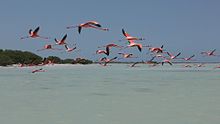
Young flamingos hatch with grayish-red plumage, but adults range from light pink to bright red due to aqueous bacteria and
The greater flamingo is the tallest of the six different species of flamingos, standing at 3.9 to 4.7 feet (1.2 to 1.4 m) with a weight up to 7.7 pounds (3.5 kg), and the shortest flamingo species (the lesser) has a height of 2.6 feet (0.8 m) and weighs 5.5 pounds (2.5 kg). Flamingos can have a wingspan as small as 37 inches (94 cm) to as big as 59 inches (150 cm).[37]
Flamingos can open their bills by raising the upper jaw as well as by dropping the lower.[38]
Behavior and ecology
Feeding

Flamingos
Though flamingos prefer to drink freshwater, they are equipped with glands under their eyes that remove extra salt from their bodies. This organ allows them to drink saltwater as well.[41]
Vocalization sounds
Flamingos are considered very noisy birds with their noises and vocalizations ranging from grunting or growling to nasal honking. Vocalizations play an important role in parent-chick recognition, ritualized displays, and keeping large flocks together. Variations in vocalizations exist in the voices of different species of flamingos.[42][43]
Life cycle


Flamingos are very social birds; they live in colonies whose population can number in the thousands. These large colonies are believed to serve three purposes for the flamingos: avoiding predators, maximizing food intake, and using scarce suitable nesting sites more efficiently.[44] Before breeding, flamingo colonies split into breeding groups of about 15 to 50 birds. Both males and females in these groups perform synchronized ritual displays.[45] The members of a group stand together and display to each other by stretching their necks upwards, then uttering calls while head-flagging, and then flapping their wings.[46] The displays do not seem directed towards an individual, but occur randomly.[46] These displays stimulate "synchronous nesting" (see below) and help pair up those birds that do not already have mates.[45]
Flamingos form strong pair bonds, although in larger colonies, flamingos sometimes change mates, presumably because more mates are available to choose.[47] Flamingo pairs establish and defend nesting territories. They locate a suitable spot on the mudflat to build a nest (the female usually selects the place).[46] Copulation usually occurs during nest building, which is sometimes interrupted by another flamingo pair trying to commandeer the nesting site for their use. Flamingos aggressively defend their nesting sites. Both the male and the female contribute to building the nest, and to protecting the nest and egg.[48] Same-sex pairs have been reported.[49]
After the chicks hatch, the only parental expense is feeding.[50] Both the male and the female feed their chicks with a kind of crop milk, produced in glands lining the whole of the upper digestive tract (not just the crop). The hormone prolactin stimulates production. Crop milk contains both fat and protein, as with mammalian milk, but unlike mammalian milk, it contains no carbohydrates.[51] (Pigeons and doves—Columbidae—also produce crop milk (just in the glands lining the crop), which contains less fat and more protein than flamingo crop milk.)[52]
For the first six days after the chicks hatch, the adults and chicks stay in the nesting sites. At around 7–12 days old, the chicks begin to move out of their nests and explore their surroundings. When they are two weeks old, the chicks congregate in groups, called "microcrèches", and their parents leave them alone. After a while, the microcrèches merge into "crèches" containing thousands of chicks. Chicks that do not stay in their crèches are vulnerable to predators.[53] When young flamingos are around three to three and a half months old, their flight feathers will finish growing in, allowing them to fly.[54]
Status and conservation
In captivity
The first flamingo hatched in a European zoo was a Chilean flamingo at Zoo Basel in Switzerland in 1958. Since then, over 389 flamingos have grown up in Basel and been distributed to other zoos around the globe.[55]
Greater, an at least 83-year-old greater flamingo, believed to be the oldest in the world, died at the Adelaide Zoo in Australia in January 2014.[56]
Zoos have used mirrors to improve flamingo breeding behaviour. The mirrors are thought to give the flamingos the impression that they are in a larger flock than they actually are.[57]
Flamingos in Ancient Roman cuisine
While many different kinds of birds were valued items in Roman food, flamingos were among the most prized in Ancient Roman cuisine. An early reference to their consumption, and especially of their tongues, is found in Pliny the Elder, who states in the Natural History:
Latin: phoenicopteri linguam praecipui saporis esse apicius docuit, nepotum omnium altissimus gurges [Translated:]
Although a few recipes for flamingos are found in Apicius' extant works, none refer specifically to flamingo tongues. The three flamingo recipes in the De re coquinaria (On the Subject of Cooking) involve the whole creature:
- 220 — roasted with an egg sauce, a recipe for wood pigeons, squabs, fattened fowl; flamingo is an afterthought.
- 230 — boiled; parrot may be substituted.
- 231 — roasted with a must sauce.[60]
Suetonius mentions flamingo tongues in his Life of Vitellius:[61]
Most notorious of all was the dinner given by his brother to celebrate the emperor's arrival in
Martial, the poet, devoted an ironic epigram, alluding to flamingo tongues:
Latin:Dat mihi penna rubens nomen; sed lingua gulosis
Nostra sapit: quid, si garrula lingua foret?
[Translated:] My red wing gives me my name; but it is my tongue that is considered savoury by epicures. What, if my tongue had been able to sing?
There is also a mention of flamingo brains in a later, highly contentious source, detailing, in the life of
In imitation of Apicius he frequently ate camels-heels and also cocks-combs taken from the living birds, and the tongues of peacocks and
Other relationship with humans
- In the Americas, the
- The Ancient Egyptian god Set is depicted with a flamingo head in the Book of the Faiyum.[68]
- Flamingos are the national bird of the Bahamas.
- Andean miners have killed flamingos for their fat, believing that it would cure tuberculosis.[69]
- In the United States, pink lawn ornaments.[70] They were first designed by Don Featherstone in 1957.[71] Their popularity was influenced in part by the prevalence of flamingo souvenirs in Florida along with the Flamingo grand hotel in Miami Beach, prompting the correlation of flamingos with style and wealth.[71]
Notes
- ^ Both forms of the plural are attested, according to the Oxford English Dictionary
References
- PMID 24580860.
- ^ "A Flamboyance of Flamingos and Other Brilliant Bird Group Names". Dictionary.com. Retrieved 1 May 2022.
- ^ Harper, Douglas. "flamingo". Online Etymology Dictionary.
- ^ Bonaparte, Charles Lucien (1831). Saggio di una distribuzione metodica degli animali vertebrati (in Italian). Rome: Antonio Boulzaler. p. 59.
- hdl:2246/830.
- ^ Salzman, Eric (December 1993). "Sibley's Classification of Birds". Ornitologia e dintorni. Archived from the original on 13 April 2018. Retrieved 15 November 2009.
- JSTOR 1366077.
- PMID 17148381. Archived from the original(PDF) on 25 March 2009. Retrieved 31 October 2009.
- ^ Feduccia, Alan (1976). "Osteological evidence for shorebird affinities of the flamingos" (PDF). Auk. 93 (3): 587. Retrieved 3 November 2009.
- S2CID 59147935.
- PMID 25504713.
- PMID 15022765.
- PMID 17148284. Archived from the original(PDF) on 25 March 2009. Retrieved 15 November 2009.
- S2CID 6472805.
- . Retrieved 3 November 2009.
- ^ ISSN 1098-660X. Retrieved 12 August 2009.
- ^ Boyd, John (2007). "NEOAVES- COLUMBEA". John Boyd's website. Retrieved 30 December 2015.
- PMID 24580860.
- ^ Gill, F and D Donsker (Eds). (2016). IOC World Bird List (v 6.3).
- S2CID 226397475. Retrieved 18 December 2019.
- ^ Scientists: Florida flamingos are native to the state, News-Press, Chad Gillis, February 23, 2018. Retrieved May 29, 2019.
- S2CID 9256162.
- S2CID 18198929.
- .
- ^ a b Rich, P.V.; van Tets, G.F.; Rich, T.H.V.; McEvey, A.R. (1987). "The Pliocene and Quaternary Flamingos of Australia". Memoirs of the Queensland Museum. 25 (1): 207–225.
- .
- ^ JSTOR 1365355.
- ^ a b Howard, H. (1955). "Fossil Birds from Manix Lake California: Descriptions of late Pleistocene bira remains, including a new species of flamingo" (PDF). Geological Survey Professional Paper. 264: 199–205.
- ^ Brodkorb, P. (1953). "A Pliocene flamingo from Florida". Natural History Miscellanea (124): 1–4.
- ^ Miller, L. (1944). "A Pliocene flamingo from Mexico" (PDF). The Wilson Bulletin. 56 (2): 77–82.
- ^ Walker, Matt (13 August 2009). "Why flamingoes stand on one leg". BBC News. Retrieved 9 December 2009.
- PMID 28539457.
- ^ ISBN 9780688094119.
- JSTOR 3247726.
- Wichita Eagle, Kaitlyn Alanis, May 27, 2019. Retrieved May 29, 2019.
- ISBN 978-0-691-16435-9.
- ^ Bradford, Alina. 2014. Flamingo Facts: Food Turns Feathers Pink. September 18. Accessed March 2018. https://www.livescience.com/27322-flamingos.html
- ., page 409.
- S2CID 87349325.
- ^ "NATURE: Fire Bird – Flamingo Facts". Pbs.org. Retrieved 30 March 2013.
- ISBN 9780688094119.
- ^ "Caribbean Flamingo". Saint Louis Zoo. Retrieved 22 February 2021.
- ^ "American Flamingo (Phoenicopterus ruber) Fact Sheet: Behavior & Ecology". San Diego Zoo Global. Retrieved 22 February 2021.
- .
- ^ OCLC 246861013.
- ^ ISBN 140813750X.
- JSTOR 1522160.
- ISBN 978-1-4081-3866-3.
- ISBN 978-0312253776.
- JSTOR 1369487.
- ^ Ann M. Ward, Amy Hunt, Mike Maslanka, and Chris Brown, Nutrient Composition Of American Flamingo Crop Milk (PDF)
{{citation}}: CS1 maint: multiple names: authors list (link) - ISBN 978-0-671-62133-9.
- JSTOR 1521484.
- ISBN 9780688094119.
- ^ "Zolli feiert 50 Jahre Flamingozucht und Flamingosforschung" [Zolli celebrates 50 years of flamingo breeding and science]. Basler Zeitung (in German). 13 August 2008. Retrieved 21 March 2010.
- ^ Fedorowytsch, Tom (31 January 2014). "Flamingo believed to be world's oldest dies at Adelaide Zoo aged 83". ABC Radio Australia. Retrieved 31 January 2014.
- ^ "Colchester Zoo use mirrors to help flamingos to breed". BBC. 26 July 2010. Retrieved 13 July 2020.
- ^ "Pliny the Elder, Naturalis Historia, liber x, chapter 67".
- ^ English (John Bostock, M.D., F.R.S., H.T. Riley, Esq., B.A., 1855)
- ^ "LacusCurtius • Pliny the Elder's Natural History — Book 10".
- ^ "C. Suetonius Tranquillus, Vitellius, chapter 13, section 2".
- ^ "Suetonius • Life of Vitellius".
- ^ "Martial, Epigrammata, book 13, LXXI Phoenicopteri".
- ^ "Martial, Epigrams. Book 13. Mainly from Bohn's Classical Library (1897)".
- ^ "Historia Augusta • Life of Elagabalus (Part 2 of 2)".
- ^ Benson, Elizabeth (1972) The Mochica: A Culture of Peru. New York, NY: Praeger Press.
- ISBN 978-0500018026.
- ^ Beinlich, Horst (2013). "Figure 7". The Book of the Faiyum (PDF). University of Heidelberg. pp. 27–77, esp.38–39.
- ^ "Flamingos". Seaworld.org. Archived from the original on 10 July 2012. Retrieved 30 March 2013.
- Christian Science Monitor. Retrieved 9 February 2010.
- ^ a b Price, Jennifer (1999). "The Plastic Pink Flamingo: A Natural History". The American Scholar. 68 (2): 5, 6 – via JSTOR.
External links
- Flamingo Resource Centre
- Flamingo videos and photos on the Internet Bird Collection
